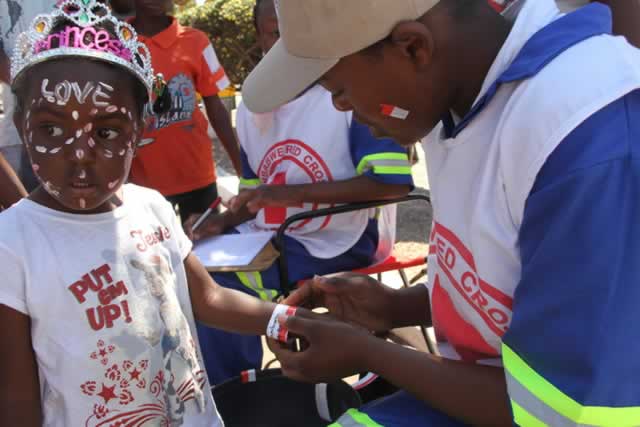What an exhibition!


A Red Cross official (above) tags a child for tracking purposes while below a man inspects some of the state-of-the-art machinery on display at the Exhibition Park during the Harare Agricultural Show
Marshall Bwanya Features Writer
The 103rd edition of the Harare Agricultural Show has come and gone. The annual event saw business, agriculture and engineering sectors showing what the country has to offer for the development of the sector.
The week-long event also brought entertainment for the show-goers. Above all, it was without incident with crime reported to be low compared to other years. It was indeed a worthy celebration of the developments in agriculture, thumbs up to the Zanu-PF policies that are driving the economy.
Agriculture is the mainstay of the economy and should get the necessary support if Zimbabwe dreams of increasing production in the local processing and manufacturing industries.
A total of 765 companies including 67 small to medium enterprises registered for the annual exhibition highlighting the success of the sector. Three hundred farmers participated in this year’s edition.
Running under the theme: “Environmental, Entrepreneurial and Educational”, the show sought to promote eco-friendly agrarian reforms, impartation of entrepreneurial skills and formation of progressive farming synergies.
Harare Agricultural Show spokesperson Miss Heather Madombwe said although the number of exhibitors fell from 780 last year to 765, the quality of products on offer has improved showing the acceptance of the exhibition on the market.
“The Harare Show is one of the country’s great success stories. It is a story of the vision, determination and acumen of society’s office bearers, over the years. It is also a story of fruitful partnership between town and country, the City Fathers and ZAS and between ZAS and the exhibitors.
“By broadening of its revenue base, the Harare Show has survived the challenging hyperinflationary years of the 2000s to remain the country’s premier exhibition. The Small and Medium Expo is trying to have another expo that basically concentrates on SMEs who on informal basis provide goods and services most corporate organisations cannot facilitate,” she said.
She said the existence and performance of SMEs is therefore crucial to our economy’s growth and recovery.
Foreign exhibitors including Iran, Italy, Israel, the Democratic Republic of Congo, Ghana and Zambia participated.
Small and medium-scale exhibitors said the show has provided the necessary advertising exposure to SMEs, commercial and multinationals to the local and international markets.
“Reviving our agricultural sector will restore Zimbabwe’s former glory of being a breadbasket in Southern Africa. This requires the participation of all sectors especially the small companies who now make the bulk of industry in Zimbabwe.
“The SMEs sector accounts for the greater percentage of employment and manufacturing hence the decision to exhibit here and more publicity,” said Nico Orgo sales and marketing director Mrs Lucia Muza.
She said there were exhibiting organic fertilisers to the people who have heavily relied on inorganic fertilisers that have unfortunately destroyed the country’s soils.
“Organic enriched fertilisers enrich soil fertility as they are not easily leached or lose nutrients. Their conservative moisture makes it easy for crops to gain access to water and other required nutrients, making it convenient for farmers to use,” she said.
Various commercial companies and small medium enterprises showcased a variety of products and services offered.
Mrs Emilda Ngwarati, a communal farmer in Chiweshe, Mazowe District, said she acquired resourceful information.
“The 103rd edition of HAS was a platform where we commercialised our products as well as attain knowledge about producing greater and better yields.
“I managed to win first prize in the 25kg peanuts competition and 10kg first price competition because of the help and assistance we are getting from several agronomists,” she said.
Mrs Ngwarati reiterated that the land reform had empowered her as a breadwinner to provide for a family of 10.
Tobacco Industry and Marketing Board director Dr Andrew Matibiri said exhibitions gave a platform for them to link farmers and suppliers for the sector to come up with synergies good for the industry.
“We discuss issues like funding, improving productivity on the farms and doing away with side-marketing which is now a scourge the industry.
“It negatively impacts most support for production as financiers will not be assured of recovering their debt through central payment processes,” he said.
Dr Matibiri reiterated that whenever insurance companies are seen to be causing discomfort to farmers and other players, TIMB does not hesitate to rein them in.
University of Zimbabwe’s Faculty of Agriculture also showcased lucrative benefits of cotton breeding.
An exhibitor with the UZ said: “Cotton breeding produces quality yields and crops less prone to diseases and it should be practiced at a wider national as means to revamp the cotton industry.
“Government and stakeholders should take initiative to facilitate new technological amenities that promote the cotton industry at lesser costs and favourable profits.”
Some farmers said it was imperative the Government focuses on provision of appropriate technologies now that land has been availed to the people.
“Some farmers had difficulties acquiring inputs and agricultural utensils required to produce better yields. These technological barriers are stalling the nation’s Green Revolution vital for economic boom.
“The agricultural sector should be heavily funded and mechanised for Zimbabwe to experience an agrarian and economic boom,” he said.
Rural Electrification Agency public relations and marketing executive Mr Johannes Nyamayedenga said new technologies would continue to be produced to aid the development of the rural and farming areas in Zimbabwe.
“REA is implementing ‘single wire earth return’ instead of the conventional three-wire grid because it is a new workable type of technology being introduced that reduces and cut costs.
“Within a kilometre, SWER uses half the amount used in a conventional three-wire grid that is why we are obliged to transmit electricity in rural areas using a single wire were load is not concentrated at some points,” he said.
The Red Cross’ child tracking system was a marvel as it helped children under the under the age of 13 tagged with parents or guardians’ phone numbers and addresses for tracking purposes.
Only a few cases of children missing were recorded, but they were soon reunited with their guardians.
Schools and farmers participated in various competitions.








Comments